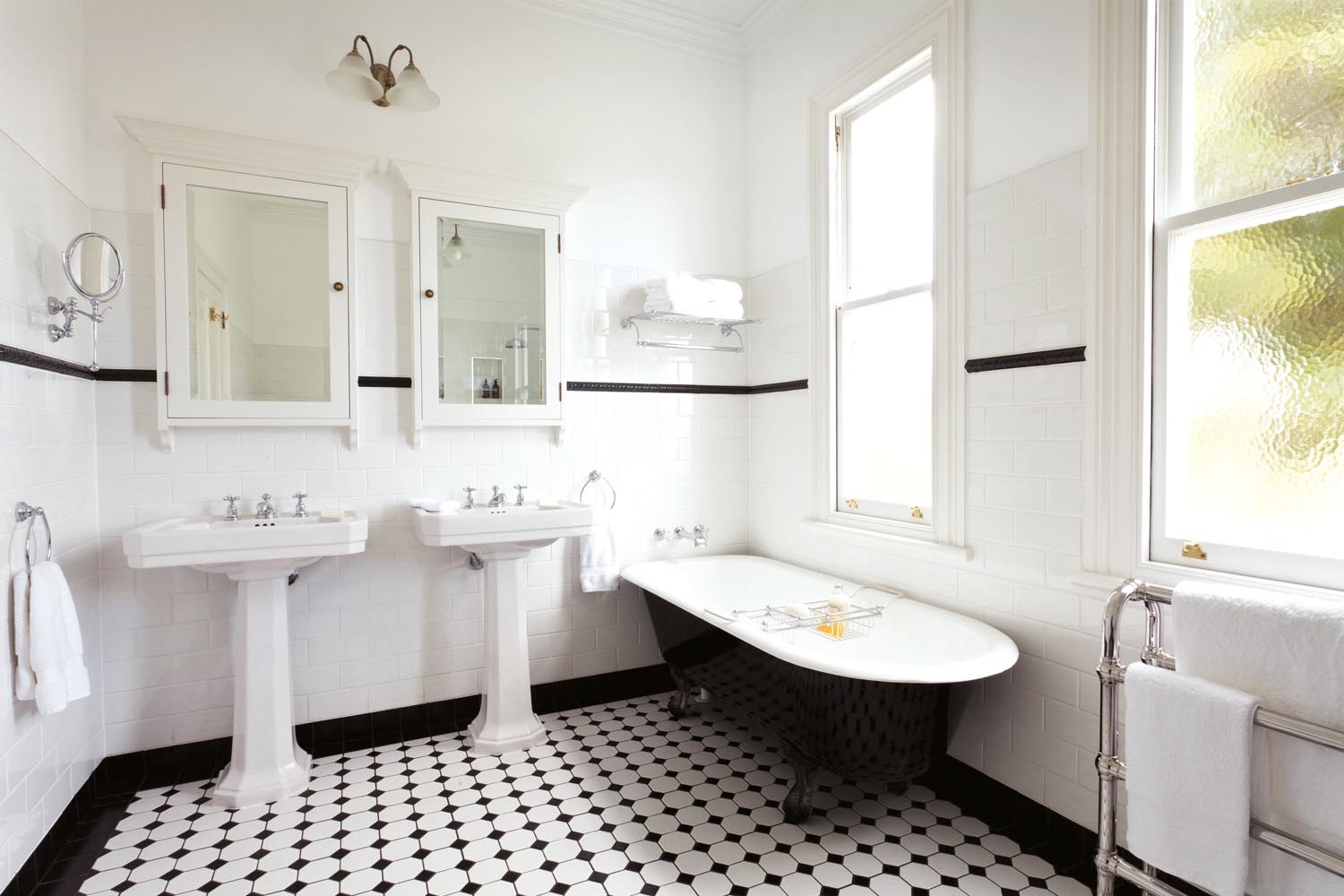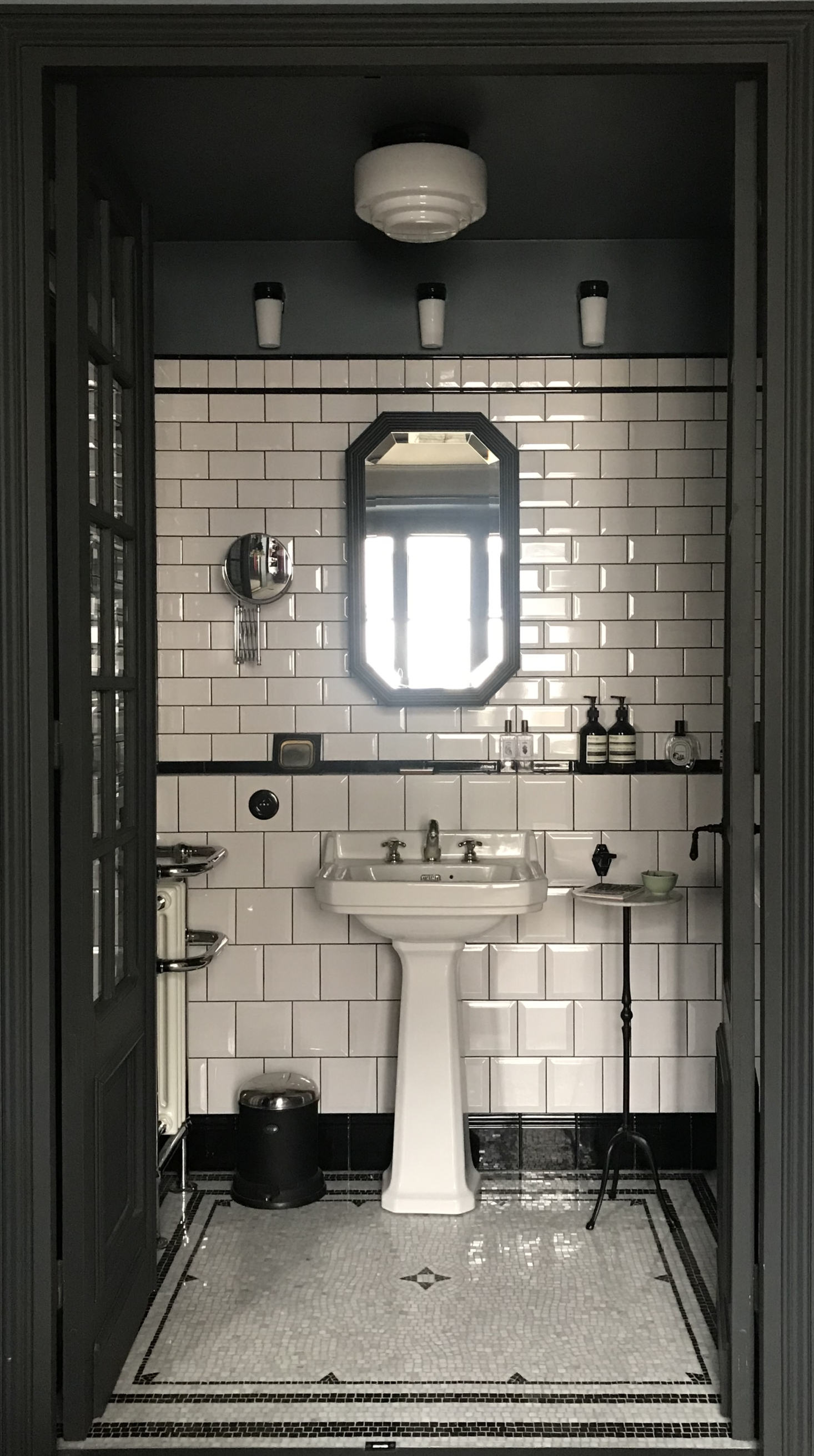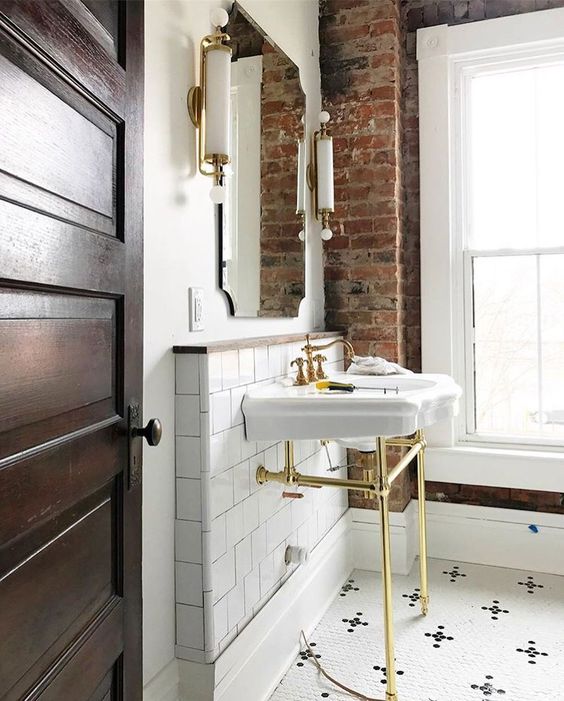Exploring the Influence of the 1920s on Bathroom Sink Design
The 1920s, also known as the Roaring Twenties, was a decade of immense cultural and artistic change. This era not only influenced fashion and architecture but also left its mark on bathroom design, including the style and functionality of bathroom sinks. Let’s see how the 1920s influenced bathroom sink design and explore some of the key features that emerged during this time.
- Art Deco Inspiration: One of the prominent influences on bathroom sink design in the 1920s was the Art Deco movement. Art Deco, characterized by its geometric shapes, bold lines, and lavish ornamentation, brought a sense of glamour and sophistication to bathroom sinks. Sinks adorned with intricate patterns, sleek lines, and streamlined silhouettes became the epitome of luxury and elegance in bathrooms of this era.
- Streamlined and Modern: The 1920s marked a shift towards a more modern and streamlined aesthetic in bathroom sink design. Gone were the bulky and ornate styles of the past, replaced by sleek and minimalist designs. The focus was on simplicity and functionality, with clean lines and smooth surfaces dominating the sink designs. This modern approach to sink design not only improved the overall look of bathrooms but also made cleaning and maintenance a breeze.
- Embracing New Materials: The 1920s witnessed the introduction of new materials in bathroom sink design. Traditional porcelain sinks were still popular, but manufacturers began experimenting with materials such as chrome, stainless steel, and vitreous china. These materials offered durability, resistance to stains, and a sleek, reflective finish, adding a touch of modernity to bathroom sinks.
- Innovative Features: The 1920s also saw the introduction of innovative features in bathroom sink design. Pedestal sinks, where the sink basin is supported by a decorative pedestal, became increasingly popular during this time. These sinks not only added a touch of elegance to bathrooms but also provided a space-saving solution for smaller bathroom spaces. Additionally, built-in storage compartments and towel bars were incorporated into sink designs, further enhancing their functionality.
- Reflecting the Times: Bathroom sink design in the 1920s was a reflection of the societal changes and values of the era. The emphasis on hygiene and cleanliness led to the popularity of sinks with built-in soap dishes and drainboards, making it easier to maintain a sanitary environment. The growing popularity of indoor plumbing also influenced sink design, with more attention given to water conservation and efficient drainage systems.

Unveiling the Glamorous Features of 1920s Bathroom Sinks
The 1920s, famously known as the Roaring Twenties, was a decade that exuded opulence and glamour. This sense of luxury extended to all areas of design, including bathroom sinks. We will take a closer look at the glamorous features of 1920s bathroom sinks and explore how they added a touch of elegance to bathrooms during this iconic era.
Elaborate Faucets: The faucets of 1920s bathroom sinks were a sight to behold. They were often made from shiny brass or chrome and featured intricate designs such as floral motifs, geometric patterns, or art deco-inspired shapes. These faucets were not only functional but also served as a focal point, adding a touch of glamour and sophistication to the sink area.
Ornate Details: One of the defining features of 1920s bathroom sinks was the attention to ornate details. Sink basins were often embellished with decorative motifs, intricate carvings, or hand-painted designs. These details added a sense of luxury and craftsmanship to the sinks, making them true works of art. Ornate pedestal bases or legs were also common, further enhancing the grandeur of the sink design.
Luxurious Materials: 1920s bathroom sinks were often crafted from luxurious materials that exuded elegance. Porcelain sinks with a smooth, glossy finish were highly sought after. Some sinks featured marbled patterns or intricate floral designs, elevating their visual appeal. Other sinks were made from materials such as vitreous china or cast iron, offering durability and a timeless aesthetic.
Mirrored Surfaces: Mirrors were an essential element of bathroom design in the 1920s, and bathroom sinks were no exception. Many sinks featured mirrored surfaces or had a built-in mirror above the sink. These mirrors not only served a practical purpose but also added a touch of glamour and reflected the overall opulence of the era.
Crystal Accents: To further enhance the luxurious feel of 1920s bathroom sinks, crystal accents were often incorporated into the design. Crystal knobs or handles on faucets added a touch of sparkle and elegance. Some sinks even featured crystal or glass basin options, creating a stunning visual effect when the water flowed through them.
How Vibrant Colors Transformed Bathroom Sink Styles in the 1920s
The 1920s, also known as the Roaring Twenties, was a decade of vibrant energy and bold self-expression. This spirit of liberation and excitement extended to bathroom design, including the use of vibrant colors in bathroom sink styles. Let’s discuss how the use of vibrant colors transformed bathroom sink styles in the 1920s, adding a sense of liveliness and personality to bathrooms of that era.
The Art of Contrast: One of the key ways vibrant colors transformed bathroom sink styles in the 1920s was through the use of contrasting color schemes. Sink basins were often made from bold, bright colors such as turquoise, pink, or yellow, creating a striking contrast against the predominantly white or neutral backgrounds of bathrooms. This use of contrasting colors added a sense of drama and visual interest to sink designs.
Playful Patterns: Vibrant colors were often accompanied by playful patterns in 1920s bathroom sink styles. Sink basins featured geometric patterns, floral motifs, or art deco-inspired designs, adding a sense of whimsy and personality to the space. These patterns not only made the sinks visually appealing but also reflected the joyful and carefree spirit of the era.
Expressing Individuality: The use of vibrant colors in bathroom sink styles during the 1920s allowed individuals to express their individuality and personal style. Rather than conforming to traditional white or neutral sinks, people embraced the opportunity to make a bold statement through their choice of color. Vibrant sinks became a way to infuse personality and character into bathrooms, transforming them from mundane spaces into vibrant havens.
Creating a Focal Point: Vibrant colored sinks became the focal point of bathrooms in the 1920s. Their eye-catching colors drew attention and became a conversation piece. By placing emphasis on the sink area, it elevated the overall design of the bathroom and created a visually stimulating environment.
Influencing Trends: The use of vibrant colors in 1920s bathroom sink styles had a lasting impact on design trends. It challenged the traditional notion that bathrooms should be purely functional spaces devoid of color and excitement. This shift towards vibrant colors paved the way for bolder design choices in subsequent decades, encouraging individuals to embrace color in all areas of their homes.
The Ornate Details and Intricate Craftsmanship of 1920s Bathroom Sinks
The 1920s, famously known as the Roaring Twenties, was a decade of opulence and intricate craftsmanship. This spirit of detailed artistry extended to bathroom sink design, where ornate details and intricate craftsmanship took center stage. Let’s talk about the ornate details and intricate craftsmanship of 1920s bathroom sinks, exploring the exquisite features that made them true works of art.
Intricate Carvings: One of the defining features of 1920s bathroom sinks was the intricate carvings that adorned them. Sink basins were often embellished with delicate floral patterns, geometric motifs, or art deco-inspired designs. Skilled craftsmen meticulously carved these details by hand, showcasing their talent and attention to detail. These carvings transformed the sinks into focal points, adding a touch of elegance and sophistication to bathrooms.
Fine Metalwork: Metalwork played a significant role in the ornate details of 1920s bathroom sinks. Faucets, handles, and other decorative elements were often made from brass, chrome, or other metals. These metals were intricately molded, engraved, or embossed with patterns, giving the sinks a sense of grandeur and luxury. The fine metalwork elevated the overall design of the sinks, turning them into functional pieces of art.
Hand-Painted Designs: Another exquisite feature of 1920s bathroom sinks was the hand-painted designs that graced their surfaces. Skilled artisans would meticulously paint intricate patterns, scenes, or motifs onto the sink basins, adding a unique and personalized touch. These hand-painted designs often featured floral arrangements, landscapes, or geometric patterns, showcasing the artistic talent and attention to detail of the craftsmen. The hand-painted designs transformed the sinks into one-of-a-kind pieces, elevating the overall aesthetic of the bathroom.
Embossed Details: Embossing was a popular technique used in 1920s bathroom sink design to create ornate details. Sink basins were embossed with intricate patterns, textures, or motifs that added depth and visual interest. This technique involved pressing or stamping the material to create raised designs, giving the sinks a three-dimensional and tactile quality. The embossed details not only enhanced the visual appeal of the sinks but also showcased the skill and craftsmanship of the artisans.
Delicate Scrollwork: Scrollwork was a common feature in 1920s bathroom sink design, adding an air of elegance and sophistication. Sink basins, faucet handles, and other decorative elements often featured delicate scrollwork patterns. These intricate designs were meticulously crafted and added a touch of grace and beauty to the sinks. The scrollwork details were often inspired by nature, with motifs such as leaves, vines, or flowers, further enhancing the overall aesthetic of the sinks.
Stained Glass Accents: Stained glass accents were another stunning feature of 1920s bathroom sinks. Some sinks featured stained glass panels or inserts, which added a vibrant and colorful element to the design. These stained glass accents often depicted intricate patterns or geometric shapes, creating a mesmerizing visual effect when light passed through them. The stained glass accents added a touch of artistry and elegance to the sinks, transforming them into captivating focal points.
The Evolution of Bathroom Sink Styles in the Roaring Twenties
The 1920s, known as the Roaring Twenties, was a time of great social and cultural change. This shift was also reflected in the design and style of bathroom sinks. In this article, we will explore the evolution of bathroom sink styles during the Roaring Twenties, from the traditional pedestal sinks to the innovative wall-mounted designs that emerged during this dynamic era.
Traditional Pedestal Sinks: At the start of the 1920s, traditional pedestal sinks were still prevalent in many bathrooms. These sinks featured a freestanding pedestal base that supported the sink basin. The pedestal sinks of the 1920s were often made from porcelain, with clean lines and classic silhouettes. While they provided a timeless and elegant look, these sinks were relatively large and took up a significant amount of space in the bathroom.
Streamlined Wall-Mounted Sinks: As the 1920s progressed, a new trend in bathroom sink design emerged – the wall-mounted sink. These sinks were attached directly to the wall, without the need for a pedestal or additional support. Wall-mounted sinks offered a sleek and streamlined look, making them ideal for smaller bathrooms or those seeking a more modern aesthetic. This new style of sink also allowed for more flexibility in bathroom design and layout.
Built-in Storage and Countertops: In the 1920s, bathroom sink styles began to incorporate built-in storage and countertops. This innovation allowed for more efficient use of space and provided additional storage options for toiletries and other bathroom essentials. Countertops were often made from durable materials such as marble or tile, adding a touch of luxury to the sink area. The inclusion of built-in storage and countertops transformed bathroom sinks into functional and practical elements of the overall bathroom design.
Art Deco Influences: The Art Deco movement, which gained popularity in the 1920s, heavily influenced bathroom sink styles of the era. Art Deco design was characterized by geometric shapes, bold lines, and lavish ornamentation. Bathroom sinks during this time featured sleek and angular silhouettes, often with intricate patterns or motifs inspired by the Art Deco style. These designs added a touch of glamour and sophistication to bathroom sink styles, reflecting the overall spirit of the Roaring Twenties.
Emphasis on Hygiene and Functionality: The 1920s marked a shift in society’s focus on hygiene and functionality, and this was reflected in bathroom sink styles. Sinks were designed with features that promoted cleanliness and made maintenance easier. Some sinks included built-in soap dishes or drainboards, allowing for easy access to soap and water. The emphasis on functionality also extended to efficient drainage systems and water conservation measures.
The Roaring Twenties brought about significant changes in bathroom sink styles. The transition from traditional pedestal sinks to innovative wall-mounted designs, the inclusion of built-in storage and countertops, the influence of Art Deco, and the emphasis on hygiene and functionality all shaped the evolution of bathroom sink styles during this dynamic era. Today, we can still appreciate and draw inspiration from the designs of the 1920s, as they continue to influence modern bathroom design and reflect the spirit of a transformative time in history.
1920s-Style Bathrooms That Inspire Rue
Rare 1920s bathroom sink from American Standard
Related Posts:
- Shut Off Water Bathroom Sink
- Vigo Gray Onyx Glass Vessel Bathroom Sink
- Wall Hanging Bathroom Sinks
- Kohler Bathroom Sink Fixtures
- Cheap Bathroom Sink Ideas
- Bathroom Sink Faucets With White Handles
- Ants In My Bathroom Sink
- Single Bowl Bathroom Sinks
- Best Way To Unblock Bathroom Sink
- Gray Undermount Bathroom Sink





